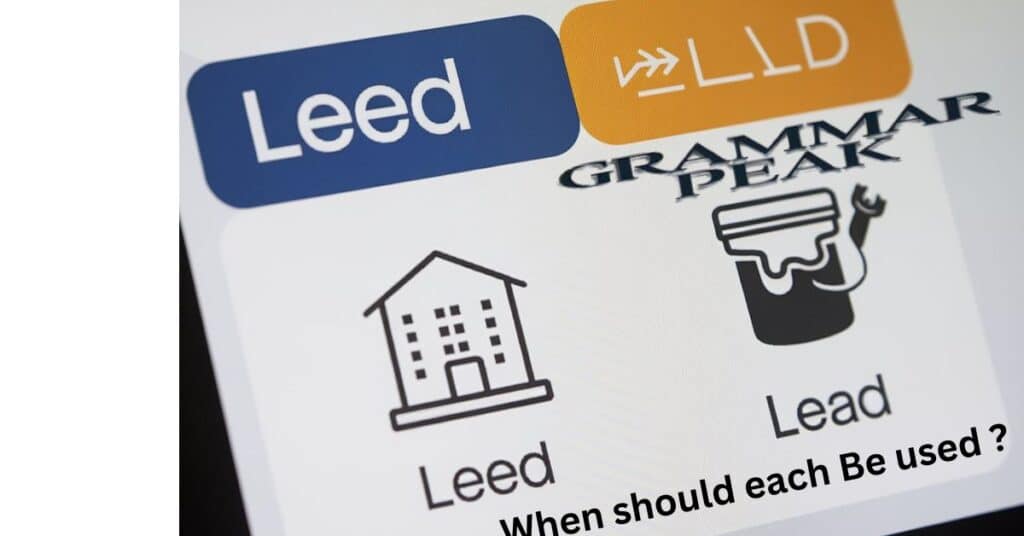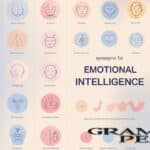Understanding the difference between lead and LEED is crucial for effective communication. These two terms often confuse people. They sound similar but mean very different things. This article will clarify when to use each term.
We will explore their meanings, origins, and applications in various contexts. By the end, you will know how to use lead or LEED correctly. Whether you are discussing leadership, sustainable building, or environmental design, this guide will help you navigate these terms with ease.
What do they Mean?
The terms lead and LEED hold different meanings. Lead can refer to guidance or direction. It can also be a heavy metal used in various industries. It has many applications in contexts like business and sales.
Lead:
Lead has multiple meanings and uses. It can refer to someone who guides or directs others. For example, a manager can lead a team to achieve its goals. In this context, leadership qualities are important. Good leaders inspire their teams and drive success.
In a different context, lead refers to a heavy metal. This heavy metal is used in batteries, radiation shielding, and more. However, it can be toxic to humans and the environment. Therefore, regulations exist to limit its use and exposure.
LEED:
LEED is a widely recognized certification for green buildings. It promotes sustainable building practices. LEED certification is awarded to buildings that meet specific criteria. These criteria include energy efficiency, water conservation, and indoor environmental quality.
The certification process assesses the building’s performance in various areas. These areas include the use of renewable energy and eco-friendly construction materials. Buildings can earn points for implementing sustainable features like solar panels and green roofs.
You will like Lead or LEED: When to Use Which One?
Origins of “Lead” and “LEED”
Origins of “Lead”:
The word lead has roots in Old English. It was originally meant to guide or direct. Over time, it also became associated with the metal used in various applications. The history of lead as a metal dates back thousands of years.
Ancient civilizations used it for plumbing, cosmetics, and other purposes. However, as awareness of its toxicity grew, its use became more regulated. Today, lead is still used in specific industries, but with caution. Understanding its origins helps us appreciate the complexities of its use.
Origins of “LEED”:
LEED was developed in the late 1990s by the USGBC. It aimed to create a standard for building sustainability. The goal was to promote environmentally friendly construction practices. Since its inception, LEED has evolved. It now includes multiple rating systems for different building types.
These systems assess various aspects, such as energy efficiency and water conservation. The LEED certification process encourages architects to think about their designs. They must consider the environmental impact of their projects. With its origins rooted in sustainability, LEED continues to shape the future of building design.
Lead or LEED: When should each be used?
Lead:
When using lead, consider the context. If discussing guidance or direction, refer to leadership qualities. In sales, use lead to describe potential customers. For example, “We generated 50 new leads this month.”When discussing the metal, be cautious.
Highlight its uses but also mention its toxicity. For instance, “Lead is used in batteries, but it can be harmful to health.”In each case, clarity is key. Ensure your audience understands which meaning you intend to convey.
LEED:
Use LEED when discussing sustainable building practices. This includes energy-efficient designs and eco-friendly materials. For example, “Our new office building has LEED certification.” When talking about architectural design, mention LEED to highlight sustainable features.
You can say, “The architects incorporated LEED principles in their design.”In urban planning discussions, LEED is relevant. It promotes smart growth and walkable neighborhoods. For instance, “The city aims for LEED certification in its urban developments.”
Comparison Table: Lead vs. LEED
| Keyword | Definition | Context | Example Usage |
| Lead | A potential customer or prospect in sales. | Sales and Marketing | “We generated 50 new leads this month.” |
| LEED | A certification for sustainable building practices. | Architecture and Construction | “The new office building is LEED Platinum certified.” |
you might be Lead or LEED: When to Use Which One?
Examples in Context
Lead:
Lead as a Metal:
- Lead is a heavy metal with the atomic number 82, known for its density and malleability.
- People commonly use lead in lead-acid batteries, which are essential for storing electrical energy in vehicles and backup power systems.
- In plumbing, lead’s softness allows people to easily shape it into pipes, although its use has declined due to health concerns.
- People also utilize lead in radiation shielding to protect medical and industrial settings where radiation exposure is a risk.
- The metal’s low melting point makes it suitable for casting and soldering applications in various manufacturing processes.
- Despite its utility, lead exposure can lead to serious health issues, including lead poisoning, which affects both children and adults.
- Governments have implemented regulations to limit lead in consumer products, particularly in paints and toys, to protect public health.
- The environmental impact of lead is significant, as it can contaminate soil and water, leading to long-term ecological
Lead as Leadership:
- People often define leadership by the ability to inspire and motivate a team toward a common goal, making effective communication essential.
- A strong leader typically possesses qualities such as empathy, vision, and decisiveness, which enable them to guide their team successfully.
- According to studies, effective leadership can increase team productivity by up to 25%, showcasing its impact on overall performance.
- Leaders who practice active listening foster a more inclusive environment, encouraging team members to share ideas and feedback.
- Delegation is a crucial skill for leaders, as it empowers team members and helps distribute workloads more efficiently.
- In times of crisis, effective leaders can maintain team morale, often reducing stress levels by as much as 30% through clear communication and support.
- Leadership styles can vary widely, with transformational leadership focusing on inspiring change and servant leadership prioritizing the needs of the team.
- Continuous leadership development is essential, with many successful leaders engaging in regular training and mentoring to enhance their skills and adapt to new challenges.
Lead in Sales Opportunities:
- In sales, a lead refers to a potential customer who has shown interest in a product or service, making them crucial for business growth.
- Research indicates that following up on leads within the first 5 minutes can increase the chances of conversion by 100 times compared to waiting longer.
- Effective lead-generation strategies can boost sales by up to 50%, highlighting the importance of identifying and nurturing potential customers.
- A well-defined sales funnel typically consists of 4 stages: awareness, interest, decision, and action, guiding leads through the buying process.
- Utilizing customer relationship management (CRM) software can help sales teams track and manage up to 300% more leads effectively.
- Leads are ranked based on their potential to convert using a method called lead scoring, allowing sales teams to prioritize their efforts more efficiently.
- On average, 60% of leads are not ready to buy, emphasizing the need for ongoing engagement and nurturing to convert them into customers.
- Successful sales professionals spend about 30% of their time on lead generation activities, underlining the significance of consistently seeking new opportunities.
LEED
LEED in Sustainable Building Practices:
- LEED certification is awarded by the U.S. Green Building Council and has become a benchmark for sustainable building practices across 160 countries.
- Buildings certified under LEED can achieve up to 40% greater energy efficiency compared to traditional buildings, significantly reducing operating costs.
- The LEED rating system includes four levels of certification: Certified, Silver, Gold, and Platinum, each representing increasing levels of sustainability.
- A LEED-certified building often incorporates rainwater harvesting systems, which can reduce water usage by up to 50%.
- By utilizing recycled materials, LEED buildings can divert over 75% of construction waste from landfills, promoting a circular economy.
- LEED emphasizes the importance of indoor environmental quality, which can improve occupant satisfaction and productivity by as much as 15%.
- Implementing LEED practices can lead to a 20% reduction in water usage through efficient plumbing fixtures and smart landscaping.
- Investing in LEED-certified buildings can increase property value by approximately 7.5%, making them attractive options for investors focused on sustainability.
LEED in Architectural Design:
- Architects aiming for LEED certification often integrate sustainable design principles from the project’s inception, impacting approximately 30% of the overall design process.
- A typical LEED-certified building can use 20% less energy than conventional structures by incorporating energy-efficient systems and materials.
- The use of green roofs in architectural design can reduce urban heat islands by as much as 70%, improving local climate conditions.
- Architects can earn up to 6 points towards LEED certification by utilizing recycled and locally sourced materials in their designs.
- Incorporating natural lighting into a building’s design can reduce the need for artificial lighting by about 50%, contributing to energy savings.
- LEED principles encourage the design of buildings that promote bicycle storage, which can increase biking access by 25% and reduce reliance on cars.
- A well-designed LEED building can improve indoor air quality, potentially reducing respiratory issues in occupants by approximately 20%.
- Architects can enhance their projects’ sustainability by including solar panels, which can provide up to 30% of a building’s energy needs, further supporting LEED certification goals.
LEED in Urban Planning:
- LEED encourages urban planners to develop walkable neighborhoods, aiming for a population density that allows 75% of residents to access amenities within a 10-minute walk.
- By promoting mixed-use zoning, LEED can reduce vehicle trips by up to 40%, fostering community interaction and decreasing traffic congestion.
- Implementing green infrastructure in urban areas can improve stormwater management, reducing runoff by as much as 50% in densely populated regions.
- LEED-certified urban developments often include public transportation options, which can increase ridership by 20%, promoting sustainable commuting practices.
- A well-planned urban environment can increase green space by 15%, enhancing community well-being and biodiversity in urban areas.
- LEED promotes energy-efficient building practices that can result in a 30% reduction in greenhouse gas emissions in newly developed urban areas.
- Integrating renewable energy sources such as solar panels in urban planning can supply up to 25% of a community’s energy needs, supporting sustainability goals.
- Cities that adopt LEED principles often see improvements in public health, with studies indicating a 10% decrease in obesity rates due to increased physical activity from walkable designs.
FAQ” S
What is LEED?
LEED (Leadership in Energy and Environmental Design) is a certification program for sustainable building practices.
Why is LEED certification important?
LEED certification promotes energy efficiency and environmental responsibility in construction and design.
How does LEED impact building costs?
While initial costs may rise, LEED buildings save up to 30% on energy costs over time.
What are the different levels of LEED certification?
LEED has four certification levels: Certified, Silver, Gold, and Platinum, based on points earned.
Can LEED certification improve property value?
Yes, LEED-certified buildings can increase property value by approximately 7.5% due to their sustainability features.
Conclusion
In conclusion, understanding when to use lead or LEED is essential. Whether discussing leadership, sustainable building, or environmental design, using these terms correctly enhances communication. By grasping their meanings and applications, you can navigate these concepts with confidence. Remember, using lead and LEED appropriately can make a significant difference in your discussions.

Mason Blake is an experienced blogger with a passion for language and communication. With years of expertise in crafting informative and engaging content, Mason shares valuable insights on grammar and writing. His clear, concise, and reader-friendly approach has earned him a loyal following, helping readers sharpen their language skills and master the art of effective communication.








Thanks for sharing. I read many of your blog posts, cool, your blog is very good.